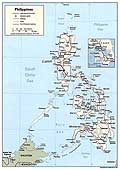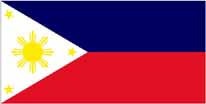-
-
- Philippines Map
|
-
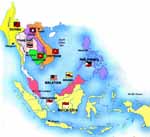
-
- Map of
- Southeast Asia
|
|
-
|
- latest picture: January 14, 2011
|
- Island of Negros
12/5/2010 - 1/12/2011 and 1/20 - 1/21/2011
|
-
-
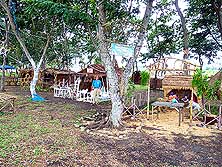
|
-
-
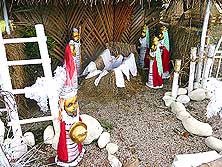
|
-
-
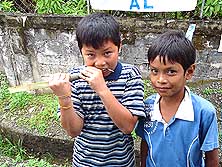
|
- 161
Christmas 2010 is approaching:
- Close to the city of Bago – South of
- Bacolod – cribs are lining up one after
- the other in a small roadside copse. All
- are made from simple materials …..
|
- 162
..... we look at all of them.
- This one we like the best
|
- 163
Two boys smile at us. One
- of them is chewing a piece of sugar
- cane that is planted everywhere on
- both sides of the road. The island of
- Negros is also called the Sugar Island
|
-
- Coming from Panay we reach towards the evening Bacolod,
an “over-half-a-million-city” and the capital of Negros Occidental. The island
owes its name to its original inhabitants, the “Negritos”. During its heydays in
the sugar cane business between 1880 and 1930 however, Negros was also named “Sugar
Island”. In the ‘Royal Am Rei’ city hotel we find a comfortable
accommodation for Peso 1’000 (US$23) that suits us – ideal to get some things
done.
|
-
-
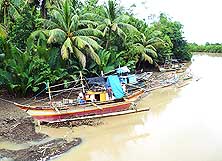
|
-
-
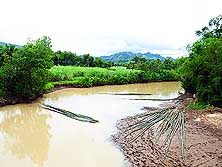
|
-
-
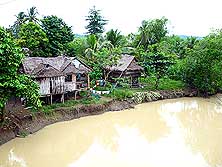
|
- 164
Brightly painted outrigger
- boats are pulled up near Cauayan
- at the palm fringed river bank .....
|
- 165
..... that is meandering lazily
- through the fertile plain .....
|
- 166
..... looking peacefully with
- its modest nipa palm huts
|
-
- We buy three oil filters at the Toyota dealer (we are short of an oil change) and apply
at the immigration for our second and last visa extension that is obtainable in every main
town. After we finally find the building with many detours due to the many one-way
streets, there is a notice at its door: “Moved”. Well, at the end we locate it
and everything is just smooth and easy. Within an hour, the extension is stamped into our
passport and we leave the immigration with Peso 15’000 (US$342!) less in our pockets.
No doubt, it is our most expensive extension ever!
|
-
-
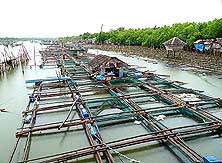
|
-
-
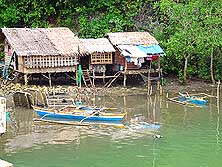
|
-
-
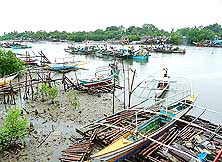
|
- 167
On the Eastern side of the
- road crossing the wide river in
- Binalbagan, oysters and mussels
- are farmed in big quantities
|
- 168
The fishermen in the plains
- live in simple, airy thatched huts,
- adjusted to its humid hot climate
|
- 169
On the Western side of the road
- rafts made from bamboo are used for
- pulling up the fishing boats at this
- swampy river bank near Binalbagan
|
-
- Urgent is also the welding of a front windscreen pillar rusted through already since
Indonesian Sumatra. Where do we find a trusty welder? Luck
has it that in the SM Supermarket we meet Ursula and Romanus from Switzerland, an early
retired couple who chose 1½ years ago the Philippines as their second home and are
building a villa in Punta Ballo near Sipalay in the Southwest of the island.
|
-
-
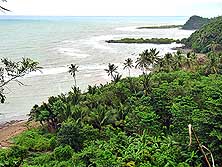
|
-
-
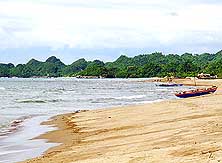
|
-
-
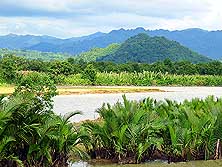
|
- 170
The Southwest coast between
- Cauayan and Sipalay is dotted with
- scattered islands covered
- with lush vegetation
|
- 171
The vast „Poblacion Beach“
- at the sprawling town of Sipalay
|
- 172
View from Sipalay over the same
- named river to the Northeast. In the front nipa
- palms are growing. Woven to mats, the palm
- leaves traditionally are used to cover the roofs
- of the huts – therefore the name “nipa huts”
|
-
- Spontaneously they invite us. Yes, they even have a welder. Awesome! Therefore a few
days later on a rainy morning we pack our bags and drive the 112 miles to the Southwest,
past rice paddies in different growing stages and huge silver green sugar cane fields.
Convoys of trucks, heavily loaded with sugar cane, rumble endlessly down the highway. The
harvest is in full progress.
|
-
-
-
-
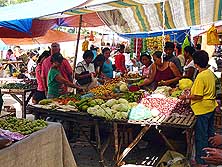
|
-
-
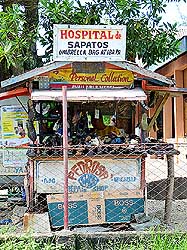
|
-
-
-
-
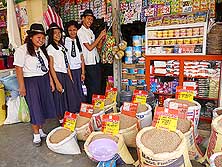
|
- 173
Monday market in Sipalay.
- Vegetable is cheep: 1 kg of sweet
- potatoes or eggplants costs 10 Peso
- (US$ 0.20), 1 kg tomatoes triply
|
- 174
A fancy shoemaker.
- „Sapatos“ means shoes – Zapatos
- in Spanish – a reminder of the
- Spanish occupation pre-1900
|
- 175
Students in their school uniform
- happily pose for a picture in front of one
- of the two “supermarkets” in Sipalay
|
-
- Through a windy road, we approach the coastal village of Sipalay and are immediately
pleasantly surprised at the beauty and remoteness of this region. Scattered outcrops
covered with dense green vegetation tower from the sea, picturesque fishing villages line
the beach. On grids tiny fish are put out to dry, fishermen are mending their nets and
children are playing joyfully at the beach.
|
-
-
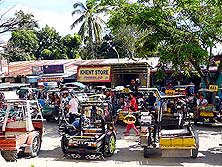
|
-
-
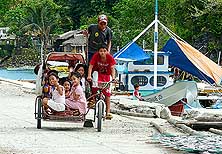
|
-
-
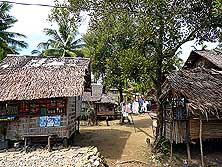
|
- 176
Motorized three wheelers gather
- at Sipalay’s main square. Westerners
- usually pay six to ten times more for
- the same distance than locals
|
- 177
It is quite hard work for the
- boy. Bicycle rickshaws are
- not so common anymore
|
- 178
Village huts with a small
- shop along the way from
- Sipalay to Punta Ballo
|
-
- Life is going here its quiet pace. The empty white sandy beaches with its colorfully
painted outriggers add to the charm. We find people more open and friendlier than before.
In Sipalay we branch off to the small side road leading to Punta Ballo. After four miles
Ursula and Romanus are already waving in front of their villa.
|
-
-
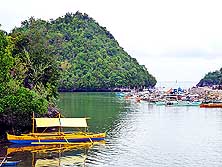
|
-
-
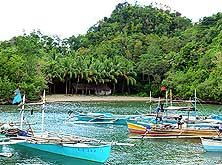
|
-
-
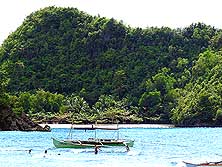
|
- 179
Along the way from Sipalay to
- Punta Ballo the view from the bridge
- over the colorful outriggers is stunning
|
- 180
Fishing boats anchor in
- this estuary in the South of Sipalay
|
- 181
Densely forested hills dominate
- the scenery around Sipalay
|
-
- We like how they live, although it looks still pretty much of a construction site: Their
house sits on a hill and is surrounded by majestic palm trees and tropical vegetation.
Through a clearing, they have ocean view. And all around it is peaceful and quiet –
simply beautiful. They have three cats, the four months playful kitten immediately finds
its way into our hearts. With Ursula and Romanus – both motivated people – we
have many things in common: Especially, we share the same joy to explore the world and the
same enthusiasm for all the exotic places.
|
-
-
-
-
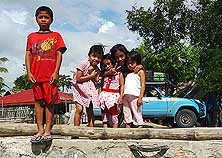
|
-
-
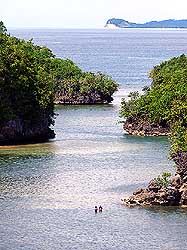
|
-
-
-
-
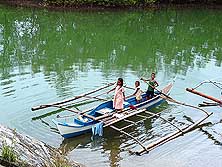
|
- 182
Children from the fisher
- community in Sipalay are keen
- to pose for a picture
|
- 183
Sea passage through small
- bays at Bulubadian Point between
- Sipalay and Punta Ballo
|
- 184
The boy shows his sisters
- who is the boss on board.
- Or is he just being a gentleman?
|
-
- Sipping a glass of homemade pineapple wine or one/two “Red Horse” beers we
spend many hours with interesting talks on their terrace. When night falls, we enjoy the
ever changing colors of the setting sun and watch the fishermen in their outrigger boats
returning home. Attracted by the light, a spotted gecko and moths suddenly appear. Can
life be more beautiful?
|
-
-
-
-
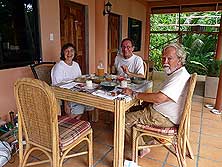
|
-
-
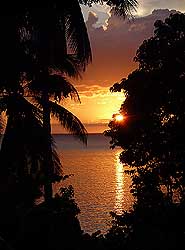
|
-
-
-
-
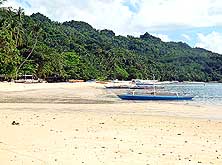
|
- 185
Punta Ballo, 4 miles from
- Sipalay: Our Swiss hosts Ursula and
- Romanus with Emil at lunch time
- on their veranda with sea view …..
|
- 186
..... from where we
- enjoy a wonderful
- sunset each evening …..
|
- 187
..... and the white beach of Punta
- Ballo is only a stone’s throw away
|
-
- Three days just spin away. On the fourth day Romanus surprises us with the offer to stay
as long as we like. Who can withstand it, having since a long time thought about where we
might escape the crowd over the coming Christmas festivities. On the fifth day, he and
Ursula fly for three weeks on vacation to Thailand and we
have the house including the three cats for ourselves.
|
-
-
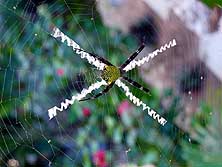
|
-
-
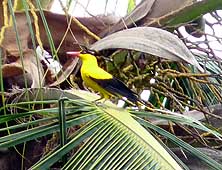
|
-
-
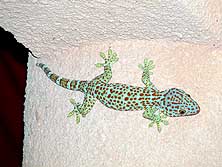
|
- 188
In Ursula’s and Romanus’
- garden we discover a spider,
- presumably a “St. Andrew’s Cross
- Spider” (Argiope), weaving its net. First
- there was only one white line, after a
- couple of days the second followed …..
|
- 189
..... each morning at the same
- time a yellow bird, a black-naped
- Oriole (Oriolus chinensis) makes
- a short but vociferous rest
- on a palm tree .....
|
- 190
..... and in the evening, a red
- dotted Tokay gecko (Gekko gecko)
- appears at the porch’s ceilings.
- Its call is not less loud
|
-
- It is not the first time that unexpectedly we can do house-sitting. It started in South
Africa, followed by Australia, USA, French Guiana, East-Malaysia
(Borneo), New Zealand and Brunei, and each time it is in its way exciting. That wi-fi was
installed only four days ago is an additional treat.
|
-
-
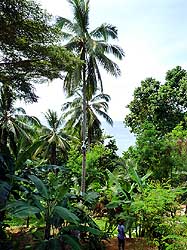
|
-
-
-
-
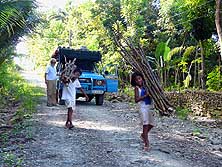
|
-
-
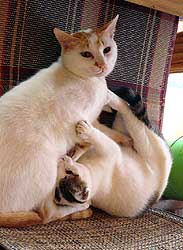
|
- 191
A boy climbs sky-high a slender
- palm tree to harvest the coconuts. Up in
- the treetop he gets bitten by a nonvenomous
- snake – it’s a pretty dangerous job
|
- 192
Collecting firewood for cooking
- is mostly the task of the children
|
- 193
An exhilarant and inseparable
- team at Ursula und Romanus:
- The male cat and its kitten
|
-
- On Christmas Day, everything matches: The ocean is as smooth as glass, the sky above us
bright blue and the tall slender palm trees sway in the light sea breeze. In the evening,
we are sitting on the porch when the red ball of the sun sets. A chicken from the grill
and a couple of beers are enough for the little celebration for the two of us. Fire flies
dance and twinkle above our head in the darkness. They make this 27th Christmas Eve far
away from home a very special one.
|
-
-
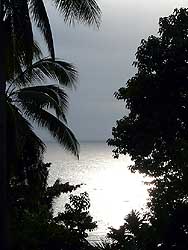
|
-
-
-
-
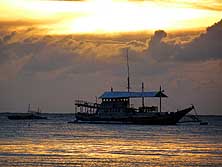
|
-
-
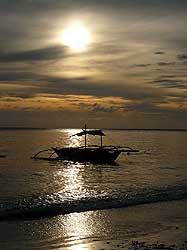
|
- 194
A thunderstorm is approaching …..
|
- 195
|
- 196
|
|
- ..... when in Punta Ballo near Sipalay – at the West coast of Negros –
- the sun sets, the mood is wonderful and peaceful
|
-
- We recall: Where in this world did we celebrate Christmas the last ten years? A year ago
it was in the Pacific in the Kingdom of Tonga. There was not much to celebrate though. I was lying in
bed with a badly infected dog bite and was worried about loosing my left leg. One year
earlier we celebrated in Vanuatu (also in the Pacific) in a
quiet Korean owned motel directly at the sea shore. 2007 Christmas was in Hong Kong, shortly before Emil’s mother died – 2006 East-Java in Indonesia. Christmas Day 2005 in Phnom
Penh/Cambodia is definitively again on the negative side, as
I broke my leg – again the left one – due to being hit by a drunken car driver;
the two years before were in the Caribbean: 2004 = Sint Maarten; 2003 = Saint
Lucia; 2002 = Guyana; 2001 = California/USA and 2000
= Texas/USA.
|
-
-
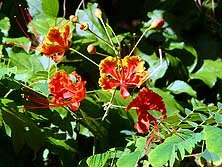
|
-
-
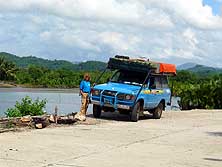
|
-
-
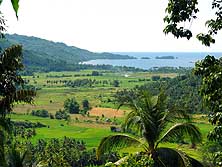
|
- 197
In the tropics flowers seem
- to gleam more brilliantly than
- elsewhere: Hibiscus
|
- 198
A remembrance picture at
- the Sipalay river before we continue
- our trip towards the South
|
- 199
From the road, South of
- Sipalay we enjoy the view
- to the Campomanes Bay
|
-
- The old year bid its farewell and the New Year dawned. We are still at the same spot.
The reason is especially the flooding and the landslides that are currently devastating
Southeastern Luzon and the islands more South of it – our next planned destination in
the East of the Philippines. Finally, after exactly 28 days (it did not feel that long),
i.e. one day after the return of Ursula and Romanus from Thailand,
we say good-bye to our new friends and head towards Dumanguete, the capital of Negros
Oriental.
|
-
-
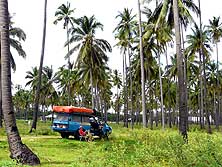
|
-
-
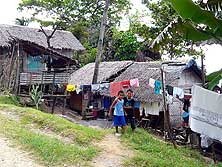
|
-
-
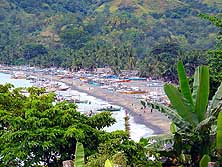
|
- 200
Along the Southwestern coastal
- road close to Hinoba-an, a palm
- grove invites to a relaxed picnic
|
- 201
Two boys pose for a picture
- in front of their thatched home
|
- 202
Wedged between steep slopes
- and the sea, short before Basay: This
- picturesque fishing village lies still on
- the side of Negros Occidental but
- close to the border of Negros Oriental
|
-
- Different things are to be blamed that we do not manage to reach Dumanguete before
darkness. Firstly, we enjoy our grilled chicken picnic intensively in a shady palm grove
along the sea shore. Secondly, we need to search for the reason why suddenly the horn
stopped working on the way, hooting being absolutely essential when overtaking. .....>
|
-
-
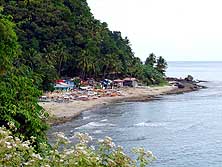
|
-
-
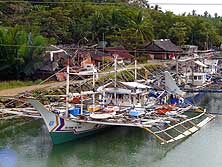
|
-
-
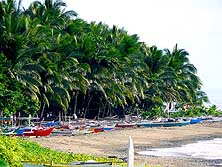
|
- 203
The cluster of fishermen huts with
- their colorful outrigger canoes on the
- small stretch of beach spread a sense
- of peaceful island life
|
- 204
Testimony of a great fisher
- nation: The big outrigger boat
- carries small canoes on board
|
- 205
Palm trees and outrigger boats
- – a tropical paradise?
|
-
- Thirdly, the plug of our “Engel” car-fridge starts to melt and Emil has to
bypass it. Fourthly, the scenery in the Southwest with its romantic sandy bays sandwiched
between lush green hills and the sea is so lovely that we take plenty of time to take
pictures. And fifthly, as a matter of principle, we drive at night only in an emergency.
|
-
-
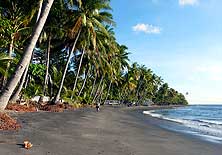
|
-
-
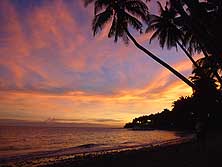
|
-
-
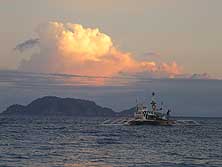
|
- 206
We relax four days at the black
- sandy beach with its leaning palm trees
- at the “Well Beach Dive Resort“ in the
- Southeast of Negros (Oriental), one
- mile North of Maluay/Zamboanguita …..
|
- 207
..... each evening we
- enjoy a beautiful sunset .....
|
- 208
..... and watch the constantly
- changing bizarre towers of clouds
- sailing above the small
- offshore island of Apo
|
-
- Therefore the sign “Well Beach Dive Resort“ one mile North of
Maluay/Zamboanguita appears just at the right moment. And there we stay not only one
night, but five. We like the black sandy beach with its bended palm trees. We like the
spacious, bright and quiet house in an adjacent garden rented additionally by the resort.
|
-
-
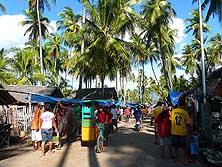
|
-
-
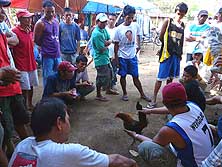
|
-
-
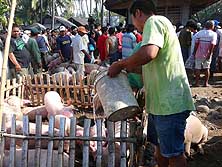
|
- 209
The weekly market under palm
- trees in the small village of Malatapay/
- Maluay is attracting the hill people
- from the whole region …..
|
- 210
..... at one corner, people debate
- about a cock. Cock fights (Sabong) are
- still wide spread in the Philippines – some
- of them are legal, the others illegal …..
|
- 211
..... at another corner pigs are
- traded. Due to their sensitive skin
- under the strong sun, water is poured
- over them once in a while
|
-
- And especially, we like the food in the restaurant. For a long time we will dream of the
Sausage-Cheese Salad, the Cordon Bleu, the Wienerschnitzel and the Pizza. The hotel is
managed by Guido, a Swiss, and his Philippines wife Marevic. The guests are mainly divers,
mostly from Germany and Switzerland.
|
-
-
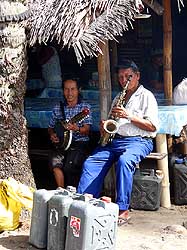
|
-
-
-
-
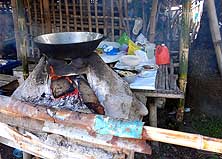
|
-
-
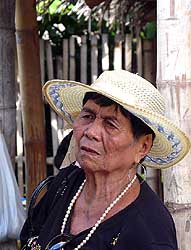
|
- 212
A couple of musicians earn a
- few pesos while making music …..
|
- 213
….. a nostalgic market kitchen .....
|
- 214
….. and a lady vendor with a
- wide brimmed hut waiting for customers
|
-
|
- Pictures from our return trip from South to North on 1/20 and 1/21/2011:
|
-
-
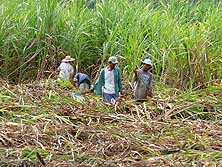
|
-
-
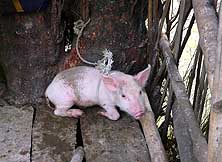
|
-
-
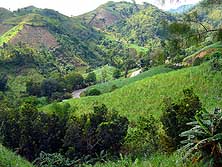
|
- 215
Sugar Cane is harvested. The
- Island of Negros is also called
- “Sugar Cane Island”. Its heyday
- was between l880 and 1930
|
- 216
Not really comfortable,
- but at least shady
|
- 217
Landscape on the inland route over
- the hills between San Carlos at the East
- coast of Negros Occidental (!) and
- its capital Bacolod in the West
|
-
- On the fifth day, one day after the big weekly market in Maluay, we give us a kick and
leave this relaxed place and at the same time also the island of Negros. The ferry in
Tampi, 10 miles North of Dumanguete, is ready for departure and the gate is closing when
we come rushing at 11.30am. We had luck as the next would have left only at 2.30pm.
|
-
-
-
-
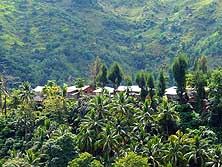
|
-
-
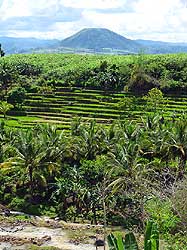
|
-
-
-
-
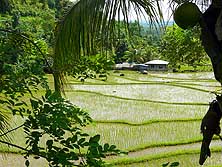
|
- 218
A small mountain village, half hidden
- by coconut trees, sits on a mountain hill on
- the inland route around the Kanlaon volcano
- between San Carlos and Bacolod …..
|
- 219
….. on our descent to the
- West, the landscape spoils us
- with lush rice terraces and another
- volcano in the distance …..
|
- 220
….. a freshly planted rice
- field that has always its special appeal
|
-
- While I run to the ticket booth and pay for the three of us Peso 870 (US$20) for a
one-hour sea journey to Bato on the island of Cebu, Emil is already boarding with the
LandCruiser. As soon as I am on the ferry too, the ramp is lifted and slowly we head out
to sea. We are sad to leave Negros as we found people and places we have grown fond of.
|
-
-
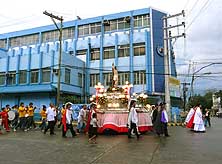
|
-
-
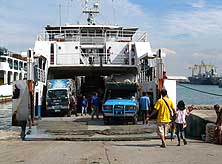
|
-
-
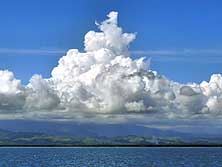
|
- 221
A Christian procession is carrying
- a statue of a saint from the San Sebastian
- Cathedral through the streets of Bacolod City
|
- 222
Our LandCruiser on the car
- ferry from the island of Negros (Bacolod)
- to the island of Panay (Dumangas)
|
- 223
The island of Negros bits
- farewell to us with an impressive sky
|
-
|
- Island of Cebu 1/13/ -
1/14/2011 and 1/19 - 1/20/2011
|
-
-
-
-
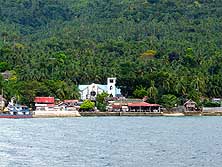
|
-
-
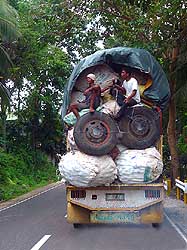
|
-
-
-
-
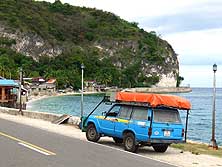
|
- 224
We are approaching the island
- of Cebu. At the landing site in Bato
- at the South coast, the blue church
- under renovation strikes the eye
|
- 225
Obviously we don't have
- the only overloaded vehicle!
|
- 226
We reach the Southern cape
- at Santander on a good tarmac road
- that mostly follows the seashore
|
-
- We have no great expectations of Cebu when we go ashore at Bato, the ferry landing at
the Southwest coast. With a population of around 2’500’000 heads, Cebu is the
second most important island after Luzon. Cebu City counts about 1 million people.
However, the only way to reach our dream destination of Bohol, leads through Cebu. At
least the stretch from Bato to the South cape has a certain island charm and the good
tarmac road runs even mostly along the sea shore. But in the East, everything is
different: Population and traffic increase, it is dirty, noisy und polluted. The closer we
come to Cebu City, the more we feel the chaos. Mid-afternoon we are fed up and make a
night stop in Carcar, 25 miles short of the mega city.
|
-
-
-
-
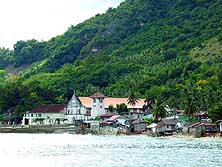
|
-
-
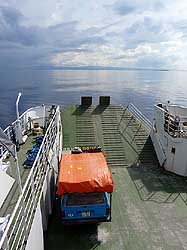
|
-
-
-
-
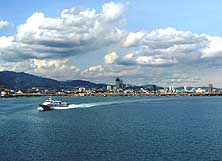
|
- 227
In the modest coastal village
- before Boljoon on the East coast
- there is an impressive old Basilica
|
- 228
Our LandCruiser is the only
- car on the ferry from Cebu City
- to Tubigon on the island of Bohol
|
- 229
Cebu City lies beneath an impressive
- cloudy sky. Counting about 2 million people it
- is the second biggest town in the Philippines
|
-
- Next morning, we have no choice than to pull out into traffic again and continue our
drive with the many three wheeler taxis and trucks that discharge thick black clouds of
smoke towards the “smog dome”of Cebu City. Both of us have only the wish to
escape. Luck has it that from the busy city port a ferry from the Lite Line is sailing to
Tubigon on the island of Bohol at noon and we manage to catch it after we have been asked
to pay at five different booths: 1) port access Peso 10. 2) Bill of Lading (yes, here a
B/L is issued!) Peso 2’210. 3) terminal handling charges for the LandCruiser Peso
168. 4) Ticket for myself (Emil as driver is included in the car’s tariff) Peso 200.
5) Terminal fees for myself Peso 10. Total Peso 2’598 (US$59). Typically a
disproportionate bureaucracy! How easy and relaxed it was on all the previous ferries,
where we simply could buy a ticket at ONE booth, like it is usually done on ro-ro-ferries!
The “Strong Republic Nautical Highway” shows still some humps.
|
-
-
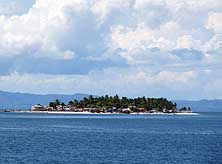
|
-
-
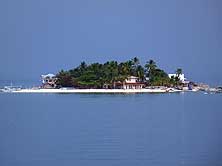
|
-
-
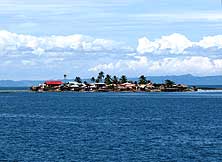
|
- 230
|
- 231
|
- 232
|
- Some small islands appear during our crossing, two of them are heavily overbuilt
|
-
- Spectacular white clouds form dramatically surreal towers over Cebu City when we take
off towards Bohol. Besides us there are only a few more
passengers on this small vessel. It is open on all sides and we are able to gaze in all
directions: To Cebu’s coast; to the scattered tiny islets, sometimes surrounded by a
sandy belt - in many cases densely populated; to the fishermen in their outrigger canoes
and to the tropical showers that pass by along Bohol’s Northeastern hills.
|
-
-
-
-
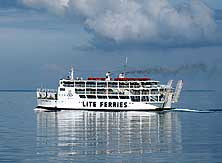
|
-
-
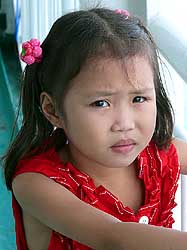
|
-
-
-
-
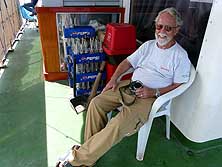
|
- 233
We are crossing the oncoming
- ferry of the “Lite Shipping” on its
- way to Cebu City …..
|
- 234
….. a young passenger
- girl follows Liliana everywhere
|
- 235
..... there is no beer on
- the ferry ….. just Pepsi!
|
-
|
-
- More websites from the Philippines:
- 2nd Visit – Part
1: Luzon (South) – Islands of Mindoro –
Panay with our vehicle from November to December
2010
- 2nd Visit – Part
3: Island of Bohol – Luzon (South)
with our vehicle in January 2011
- 1st Visit to the
Philippines: Luzon (North) without vehicle in February 2008
|
![]()
